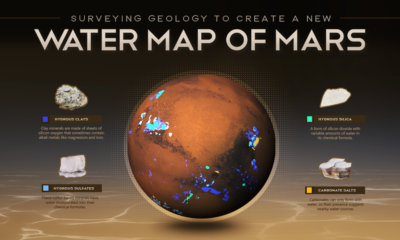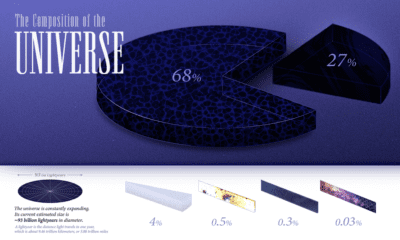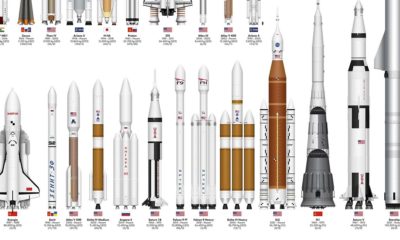Misc
Watching the Sky Fall: Visualizing a Century of Meteorites
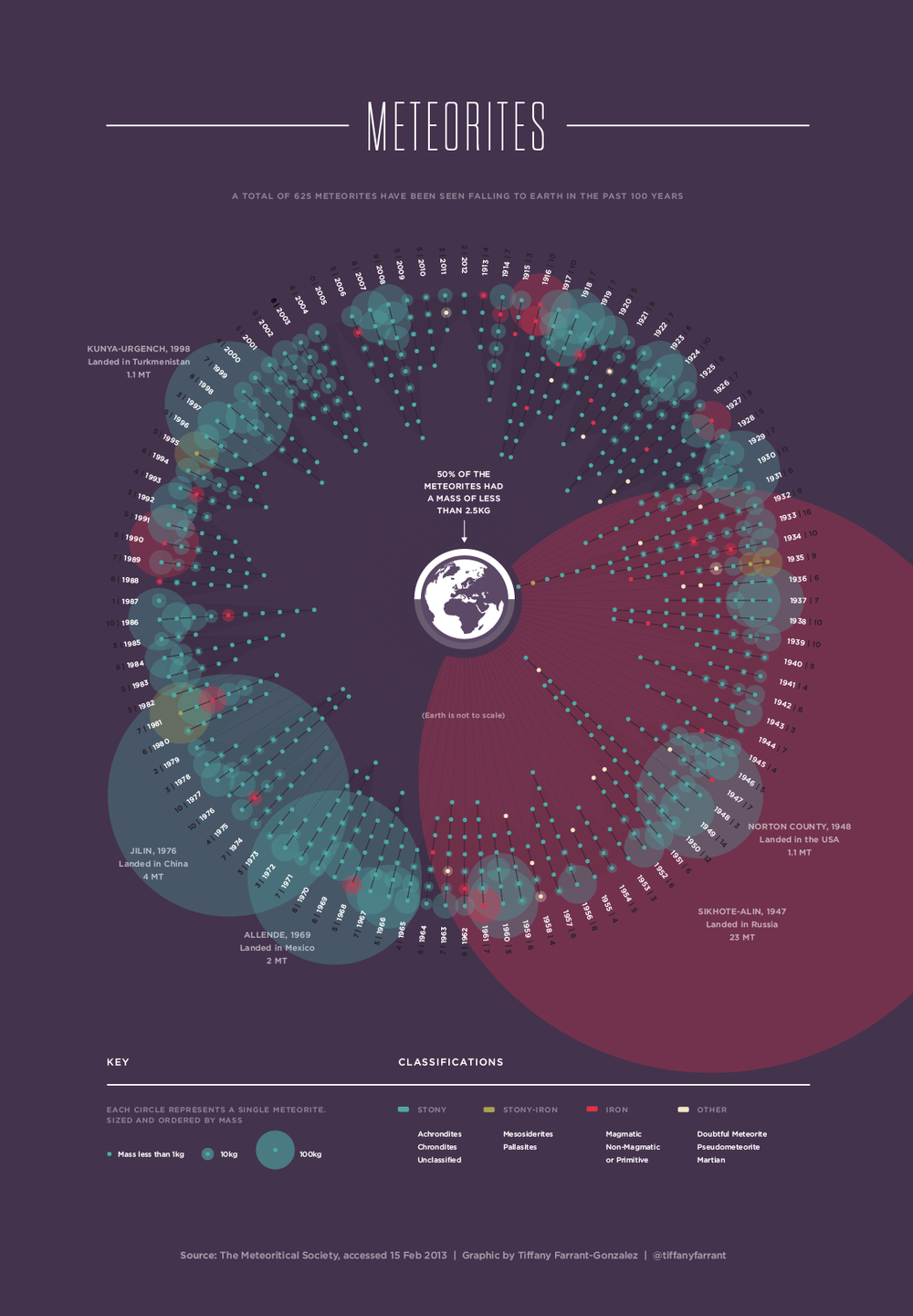
Watching the Sky Fall: Visualizing a Century of Meteorites
Astrophysicist Neil DeGrasse Tyson once said “The chances that your tombstone will read ‘Killed by an Asteroid’ are about the same as they’d be for ‘Killed in Airplane Crash’.”
Part of the reason for this is the Earth’s atmospheric ability to burn up inbound space rocks before they reach the surface, a process that ensures that most meteors never become meteorites.
Of the 33,162 meteorites found in the past 100 years, only 625 were seen. Today’s visualization from data designer Tiffany Farrant-Gonzalez groups these 625 observed meteorites by the year they fell, classification, mass, and landing location on Earth.
Asteroid, Meteoroids, Meteors, and Meteorites
Not all flying space rocks are the same. Their origins and trajectories define its type.
Asteroid: A large rocky body in space, in orbit around the Sun.
Meteoroid: Much smaller rocks or particles in orbit around the Sun.
Meteor: If a meteoroid enters the Earth’s atmosphere and vaporizes, it becomes a meteor, or a shooting star.
Meteorite: If a small asteroid or large meteoroid survives its fiery passage through the Earth’s atmosphere and lands on Earth’s surface.
Bolide: A very bright meteor that often explodes in the atmosphere, also known as a fireball.
Classification
This graphic classifies meteorites into four types based on their composition: stony, stony-iron, iron and other.
| Stony | Stony-Iron | Iron | Other |
|---|---|---|---|
| Achondites Chrondites Unclassifed | Mesoiderites Pallasites | Magmatic Non-magmatic or Primitive | Doubtful Meteorites Pseudometeorite |
Top 5 Meteorites by Size
While half of all observed meteorites weighed less than 2.5 kg (5.5 lbs), there are a few exceptional ones that stand out. The graphic highlights the five largest meteorites ever observed, and when they fell:
| Locaton | Size | Year | Type |
|---|---|---|---|
| Sikhote-Alin, Russia | 23 MT | 1947 | Iron |
| Jilin, China | 4 MT | 1976 | Stony |
| Allende, Mexico | 2 MT | 1969 | Stony |
| Norton County, USA | 1.1 MT | 1948 | Stony |
| Kunya-Urgench, Turkmenistan | 1.1 MT | 1998 | Stony |
Each category differs in their amount of iron-nickel metal and what they reveal about the early solar system.
Fireballs in the Sky: Bolides
Small asteroids frequently enter and disintegrate in Earth’s atmosphere randomly around the globe, creating fireballs known as bolides. NASA’s Near-Earth Object Program mapped data gathered by U.S. government sensors from 1994 to 2013.
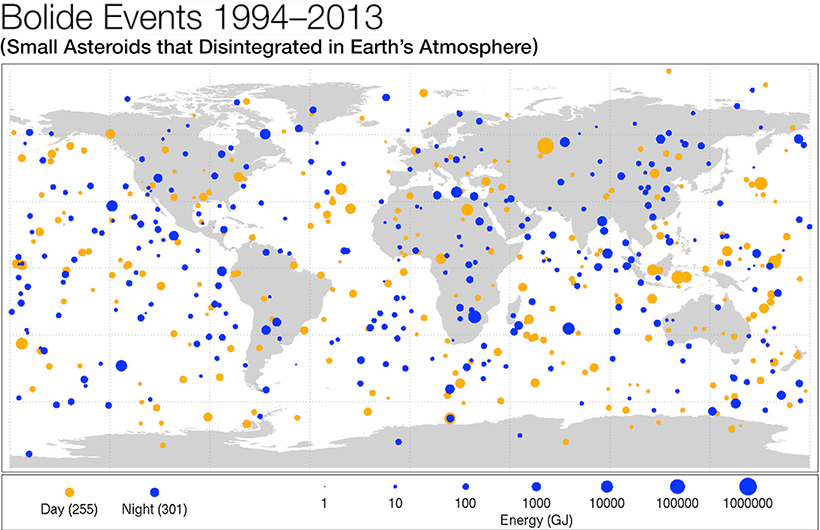
Source: NASA
The data indicates that small asteroids impacted Earth’s atmosphere, resulting in a bolide (or fireball), on 556 separate occasions over a 20-year period. Almost all asteroids of this size disintegrate in the atmosphere and are harmless.
A notable exception was the Chelyabinsk event in 2013, which was the largest known natural object to have entered Earth’s atmosphere since the 1908 Tunguska event. A house-sized asteroid entered the atmosphere over Chelyabinsk at over 11 miles per second, and blew apart 14 miles above the ground.
The explosion released an energy equivalent to ~440,000 tons of TNT, generating a shock wave that shattered windows over 200 square miles—damaging several buildings and injuring over 1,600 people.
Look Out Above
While the night sky appears to be a beautiful tableau of the cosmos, these two visualizations paint a dramatic galactic battle. Rocks inundate our planet as it moves through the darkness of space. The resiliency of Earth’s atmosphere to erode these invaders has allowed life to flourish—until the next big one comes through.
Remember the Dinosaurs?
Misc
How Hard Is It to Get Into an Ivy League School?
We detail the admission rates and average annual cost for Ivy League schools, as well as the median SAT scores required to be accepted.

How Hard Is It to Get Into an Ivy League School?
This was originally posted on our Voronoi app. Download the app for free on iOS or Android and discover incredible data-driven charts from a variety of trusted sources.
Ivy League institutions are renowned worldwide for their academic excellence and long-standing traditions. But how hard is it to get into one of the top universities in the U.S.?
In this graphic, we detail the admission rates and average annual cost for Ivy League schools, as well as the median SAT scores required to be accepted. The data comes from the National Center for Education Statistics and was compiled by 24/7 Wall St.
Note that “average annual cost” represents the net price a student pays after subtracting the average value of grants and/or scholarships received.
Harvard is the Most Selective
The SAT is a standardized test commonly used for college admissions in the United States. It’s taken by high school juniors and seniors to assess their readiness for college-level academic work.
When comparing SAT scores, Harvard and Dartmouth are among the most challenging universities to gain admission to. The median SAT scores for their students are 760 for reading and writing and 790 for math. Still, Harvard has half the admission rate (3.2%) compared to Dartmouth (6.4%).
| School | Admission rate (%) | SAT Score: Reading & Writing | SAT Score: Math | Avg Annual Cost* |
|---|---|---|---|---|
| Harvard University | 3.2 | 760 | 790 | $13,259 |
| Columbia University | 3.9 | 750 | 780 | $12,836 |
| Yale University | 4.6 | 760 | 780 | $16,341 |
| Brown University | 5.1 | 760 | 780 | $26,308 |
| Princeton University | 5.7 | 760 | 780 | $11,080 |
| Dartmouth College | 6.4 | 760 | 790 | $33,023 |
| University of Pennsylvania | 6.5 | 750 | 790 | $14,851 |
| Cornell University | 7.5 | 750 | 780 | $29,011 |
*Costs after receiving federal financial aid.
Additionally, Dartmouth has the highest average annual cost at $33,000. Princeton has the lowest at $11,100.
While student debt has surged in the United States in recent years, hitting $1.73 trillion in 2023, the worth of obtaining a degree from any of the schools listed surpasses mere academics. This is evidenced by the substantial incomes earned by former students.
Harvard grads, for example, have the highest average starting salary in the country, at $91,700.
-

 Real Estate2 weeks ago
Real Estate2 weeks agoVisualizing America’s Shortage of Affordable Homes
-

 Technology1 week ago
Technology1 week agoRanked: Semiconductor Companies by Industry Revenue Share
-

 Money1 week ago
Money1 week agoWhich States Have the Highest Minimum Wage in America?
-

 Real Estate1 week ago
Real Estate1 week agoRanked: The Most Valuable Housing Markets in America
-

 Business2 weeks ago
Business2 weeks agoCharted: Big Four Market Share by S&P 500 Audits
-

 AI2 weeks ago
AI2 weeks agoThe Stock Performance of U.S. Chipmakers So Far in 2024
-

 Misc2 weeks ago
Misc2 weeks agoAlmost Every EV Stock is Down After Q1 2024
-

 Money2 weeks ago
Money2 weeks agoWhere Does One U.S. Tax Dollar Go?




